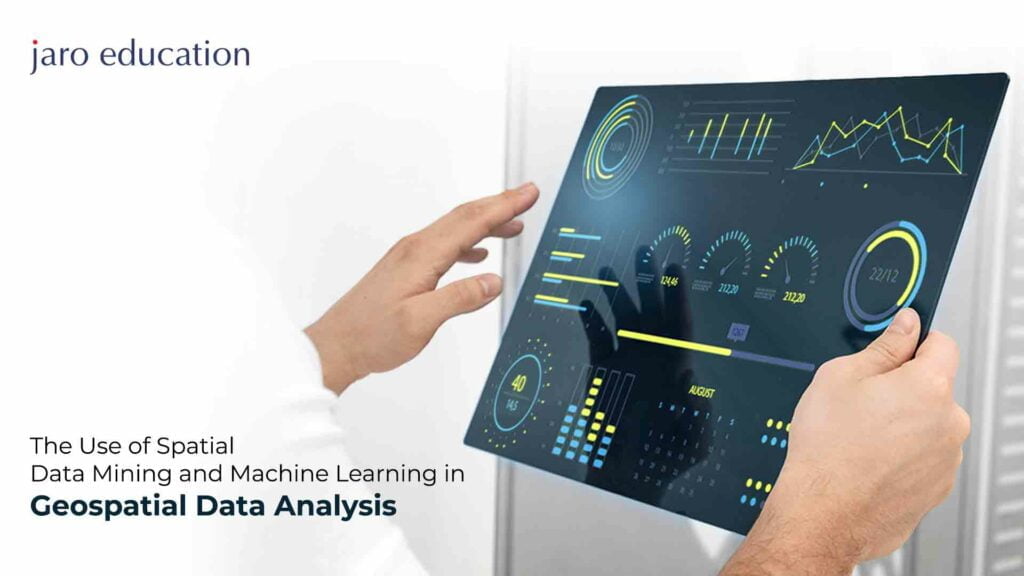Spatial data mining and machine learning, when combined, allow geospatial analysts to gain insights into a wide range of domains, including environmental monitoring, urban planning, public health, and transportation. This has resulted in the development of a variety of applications, including real-time traffic prediction, land-use classification, and natural disaster predictive modelling. In this context, spatial data mining and machine learning are becoming increasingly important for researchers, analysts, and decision-makers to make informed decisions based on geospatial data analysis.
What is Spatial Data Mining?
The process of discovering new and interesting patterns and relationships in geospatial data. There are specific techniques and methods in spatial data mining, which are as follows:
Clustering
It is a technique that involves grouping together similar objects or data points based on some similarity metric. Clustering is used in spatial data mining to group similar geographic areas based on their attributes.
Classification
It is a technique that involves categorising objects or data points based on their attributes. Classification in spatial data mining can be used to categorise geographic areas based on land use, soil type, or other environmental factors.
Association Rule Mining
It is a technique for discovering associations or relationships between variables in a dataset. Association rule mining can be used in spatial data mining to identify relationships between different geographic variables, such as land use and environmental factors.
Outlier Detection
It is the process of identifying data points that differ significantly from the rest of the data. Outlier detection in spatial data mining can be used to identify anomalous geographic areas based on their environmental, social, or economic characteristics.
Spatial Regression
It is a technique for modelling the relationship between a dependent variable and one or more independent variables while accounting for spatial data autocorrelation. Spatial regression can be used in spatial data mining to model the relationship between various geographic variables, such as land use and environmental factors.
Spatial Decision Trees
A type of machine learning algorithm that can be used to classify geographic areas based on their attributes. In spatial data mining, spatial decision trees can be used to identify the most important factors influencing land use, environmental factors, or other geographic variables.
What is Machine Learning?
It is a subset of artificial intelligence in which algorithms are used to learn from data and make predictions or decisions. There are different types of Machine Learning, which are as follows:
Supervised learning
The goal of supervised learning is to learn a function that can predict the target variable accurately for new, unlabeled data. It is a type of machine learning algorithm that involves training a model on a labelled dataset with a known outcome or target variable for each data point. Linear regression, logistic regression, decision trees, random forests, and support vector machines are examples of supervised learning algorithms (SVMs) examples.
Unsupervised learning
Unsupervised learning seeks to discover patterns and structures in data. It is a type of machine learning algorithm that involves training a model on an unlabeled dataset with an unknown target variable. , principal component analysis (PCA), and anomaly detection.
Reinforcement learning
In robotics, game AI, and control systems, reinforcement learning is frequently used. It is a type of machine learning algorithm in which an agent learns to make decisions in an environment through trial and error. The agent is rewarded or penalised for each action it takes, with the goal of increasing the total reward over time.
Integration of Spatial Data Mining & Machine Learning
Preprocessing spatial data
Prior to applying machine learning algorithms, spatial data must be preprocessed to handle missing values, outliers, and spatial autocorrelation. Techniques such as data cleaning, feature selection, and spatial normalisation are examples of spatial data preprocessing.
Feature engineering
It entails selecting or creating a set of features that best capture the data’s patterns and relationships. Environmental factors, land-use data, and socioeconomic data can all be included in geospatial data analysis.
Model selection and training
Model selection entails selecting the best machine learning algorithm for the task at hand, followed by training the model on preprocessed data. The algorithm used is determined by the problem type, the dataset size, and the features’ characteristics.
Model evaluation and tuning
Once the model has been trained, it must be evaluated to assess its performance and identify areas for improvement. Model evaluation techniques include cross-validation, and model tuning techniques include hyperparameter optimisation.
Interpretation & evaluation
The results of the machine learning analysis must be interpreted and visualised before they can be communicated to stakeholders. Interpretation entails identifying the data’s most important features and patterns, whereas visualisation entails using techniques such as heatmaps, scatterplots, and interactive maps.
Challenges and Limitations of Spatial Data Mining and Machine Learning in Geospatial Data Analysis
Data quality
Geospatial data is frequently incomplete, inconsistent, or erroneous, resulting in inaccurate or biased results.
Spatial autocorrelation
Spatial autocorrelation is a characteristic of spatial data in which neighbouring data points are more likely to be similar than distant ones. This can lead to overfitting and inaccurate results if not taken into account.
High-dimensional data
Geospatial data can be high-dimensional, with a large number of variables, making it difficult to identify relevant patterns and relationships.
Data integration
Because of differences in formats, scales, and projection systems, it can be difficult to integrate spatial data from multiple sources.
Data Visualization
Spatial data can be complex and difficult to interpret, and visualisation techniques can be limited by the requirement to represent 3D data in 2D formats.
Computational resources
Spatial data mining and machine learning algorithms can be computationally intensive, making them difficult to implement on large datasets.
Privacy and security
Geospatial data can contain sensitive information, and ensuring privacy and security in spatial data mining and machine learning applications can be difficult.
Advanced Data Science Certificate Program
With the world-class Rotman School of Management (University of Toronto) and IIT Jammu Advanced Data Science Certificate Program, you can gain global data literacy. This experiential, innovative, and comprehensive programme is tailored to talented individuals seeking a transformative learning experience in data science. Participants will learn about cutting-edge data analytics tools and techniques for extracting insights from real-world data.
The programme pedagogy is comprised of an interdisciplinary curriculum and interdepartmental collaboration efforts of the University of Toronto’s Rotman School of Management, Department of Statistical Sciences, and Department of Computer Science in design and delivery.
Conclusion
Finally, the use of spatial data mining and machine learning in geospatial data analysis has grown in importance, providing valuable insights into complex spatial phenomena. However, these techniques face several challenges and limitations in terms of data quality, spatial autocorrelation, high-dimensionality, data integration, interpretation, visualisation, computational resources, privacy, and security.
Addressing these challenges necessitates careful consideration of the specific geospatial data analysis problem at hand, the appropriate spatial data mining and machine learning techniques to employ, careful attention to data quality and integration, and careful interpretation and visualisation of results. Despite these obstacles, spatial data mining and machine learning have enormous potential for improving our understanding of spatial patterns and relationships and contributing to developing effective geospatial data analysis.





